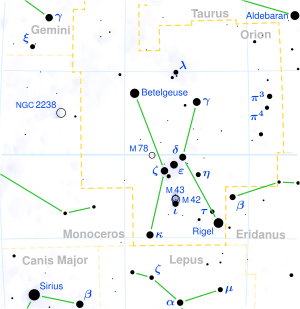Pi6 Orionis

| |
| Observation data Epoch J2000.0 Equinox J2000.0 (ICRS) | |
|---|---|
| Constellation | Orion |
| Right ascension | 04h 58m 32.90210s[1] |
| Declination | +01° 42′ 50.4582″[1] |
| Apparent magnitude (V) | 4.469[2] |
| Characteristics | |
| Spectral type | K0/1 III[3] |
| U−B color index | +1.506[2] |
| B−V color index | +1.390[2] |
| Astrometry | |
| Radial velocity (Rv) | +15.36±0.24[4] km/s |
| Proper motion (μ) | RA: −1.30[1] mas/yr Dec.: −7.67[1] mas/yr |
| Parallax (π) | 3.45 ± 0.30[1] mas |
| Distance | 950 ± 80 ly (290 ± 30 pc) |
| Details[5] | |
| Mass | 4.15±0.68 M☉ |
| Radius | 87.73±9.79 R☉ |
| Luminosity | 2,185.6±418.7 L☉ |
| Surface gravity (log g) | 1.20±0.15 cgs |
| Temperature | 4,217±121 K |
| Metallicity [Fe/H] | −0.23±0.10 dex |
| Rotational velocity (v sin i) | 8[6] km/s |
| Age | 230±11 Myr |
| Other designations | |
Pi6 Orionis (π6 Ori, π6 Orionis) is a solitary[8] star in the eastern part of the constellation Orion. It is visible to the naked eye with an apparent visual magnitude of 4.469.[2] Based upon an annual parallax shift of 3.45 mas,[1] it is around 950 light years from the Sun. At that distance, the visual magnitude of the star is reduced by an interstellar absorption factor of 0.52.[4]
This is an evolved K-type giant star on the horizontal branch,[5] with a stellar classification of K0/1 III.[3] It is a suspected variable star with a measured variation between 4.45 and 4.49 in visual magnitude.[9] Pi6 Orionis has over four times the mass of the Sun and has expanded to around 88 times the Sun's radius. Over the course of its life span, the star has shed around 0.04±0.01 solar masses. With an effective temperature of 4,217 K in its outer atmosphere it is radiating roughly 2,200 times the solar luminosity.[5]
References
- 1 2 3 4 5 6 van Leeuwen, F. (2007), "Validation of the new Hipparcos reduction", Astronomy and Astrophysics, 474 (2): 653–664, arXiv:0708.1752
 , Bibcode:2007A&A...474..653V, doi:10.1051/0004-6361:20078357.
, Bibcode:2007A&A...474..653V, doi:10.1051/0004-6361:20078357. - 1 2 3 4 Cousins, A. W. J. (1984), "Standardization of Broadband Photometry of Equatorial Standards", South African Astronomical Observatory Circulars, 8: 59, Bibcode:1984SAAOC...8...59C.
- 1 2 Houk, N.; Swift, C. (1999), "Michigan catalogue of two-dimensional spectral types for the HD Stars", Michigan Spectral Survey, 5, Bibcode:1999MSS...C05....0H.
- 1 2 Famaey, B.; et al. (2005), "Local kinematics of K and M giants from CORAVEL/Hipparcos/Tycho-2 data. Revisiting the concept of superclusters", Astronomy and Astrophysics, 430: 165, Bibcode:2005A&A...430..165F, doi:10.1051/0004-6361:20041272.
- 1 2 3 Reffert, Sabine; et al. (2015), "Precise radial velocities of giant stars. VII. Occurrence rate of giant extrasolar planets as a function of mass and metallicity", Astronomy and Astrophysics, 574A (2): 116–129, arXiv:1412.4634
 , Bibcode:2015A&A...574A.116R, doi:10.1051/0004-6361/201322360.
, Bibcode:2015A&A...574A.116R, doi:10.1051/0004-6361/201322360. - ↑ Bernacca, P. L.; Perinotto, M. (1970), "A catalogue of stellar rotational velocities", Contributi Osservatorio Astronomico di Padova in Asiago, 239 (1), Bibcode:1970CoAsi.239....1B.
- ↑ "pi.06 Ori -- Variable Star", SIMBAD Astronomical Database, Centre de Données astronomiques de Strasbourg, retrieved 2016-11-22.
- ↑ Eggleton, P. P.; Tokovinin, A. A. (September 2008), "A catalogue of multiplicity among bright stellar systems", Monthly Notices of the Royal Astronomical Society, 389 (2): 869–879, arXiv:0806.2878
 , Bibcode:2008MNRAS.389..869E, doi:10.1111/j.1365-2966.2008.13596.x.
, Bibcode:2008MNRAS.389..869E, doi:10.1111/j.1365-2966.2008.13596.x. - ↑ Kukarkin, B. V.; et al. (1981), "Catalogue of suspected variable stars", Nachrichtenblatt der Vereinigung der Sternfreunde e.V., Bibcode:1981NVS...C......0K.